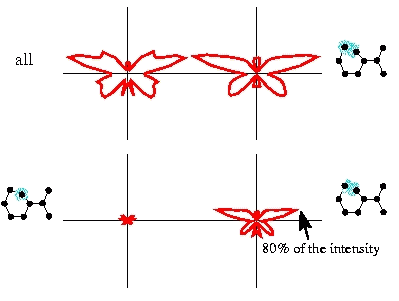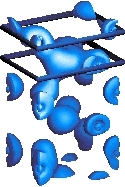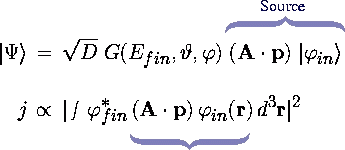GaAs(110)
Photocurrent from selected bonds
 |
Charge density
 |
| Photocurrent for Ein = -4.0 eV and
k|| = 0.6 Å-1:
partial currents emerging from selected bonding areas. The pictograms
indicate the considered areas. Shown is a projection along the x
direction, which belongs to the small side of the frames in the
charge image on the right. The y direction extends to the right in
the pictograms, the
vacuum is above, and the crystal extends below the shown part. Black
are atoms and
bonds, the blue shading gives the considered areas. For example,
the upper right current stems
from the uppermost zigzag chains including spheres around the As atom
but not around
the Ga atom.
|
|
Charge iso-surface for the initial state
belonging to the upper right lobe in the photocurrents.
The frames indicate the unit cell in the topmost atomic planes.
The uppermost As atoms are in the corners of the upper frame.
|
 The origin of photoelectrons can be traced
to single bonds. The origin of photoelectrons can be traced
to single bonds.
 The amplitude of the initial state appears
as the local emissivity of the electrons to be scattered. The amplitude of the initial state appears
as the local emissivity of the electrons to be scattered.
Interpretation

Formulas for the photoelectron state and the photocurrent. D is a
(surface) density of states extracted from the initial state, G is the
Greens function, depending on the final energy and the emission
angles, A is the vector potential of the incident light, and p is the momentum
operator. In the upper formula G describes the propagation of the excited
electron, resulting in a photoelectron, whereas below the current
is given by a Golden Rule formula as transition probability between the
excited state and the photoemission final state. In both cases the
photoexcited state can be seen as the source of the electrons. The spatial
distribution of delocalized states gives a local emissivity.
This extends the usual photoelectron diffraction picture to the case of the
nonlocalized initial valence states.
|


![]()
![]()
